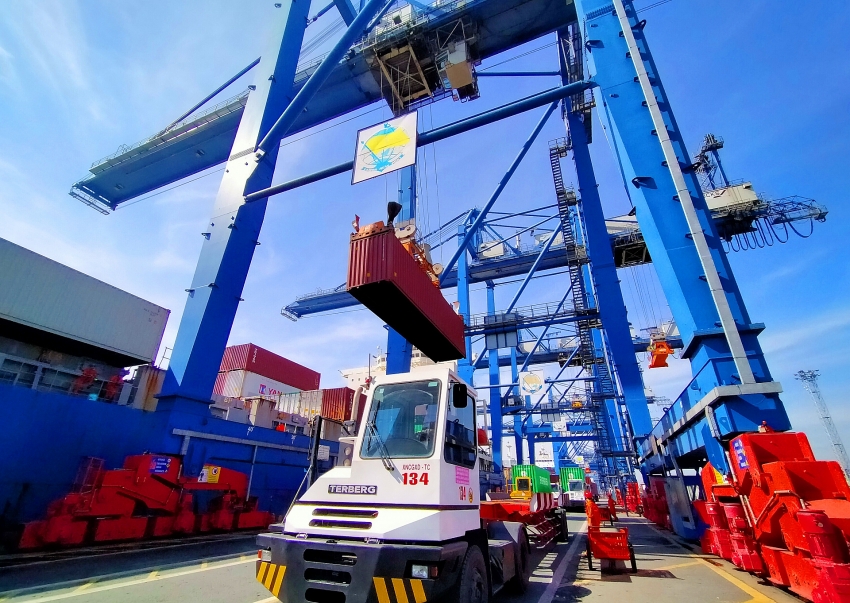Over the past three weeks, newly-established Thai-invested Amuay Textile and Garment Co., Ltd. at Hanoi’s Quang Minh Industrial Park has resumed operations of its three production lines after a month-long halt caused by COVID-19 which prevented the firm from exporting its products to some European nations.
“We have recently landed an export order from a Canadian partner, with a total contract value of $1 million. We will boost production to ship goods to Canada in June or July,” said Vu Thai Hang, vice head of the company’s marketing department. “Canada is a new market for us, and import tariffs on garments and textiles have begun to reduce in this year under the Comprehensive and Progressive Agreement for Trans-Pacific Partnership (CPTPP).”
 |
| Vietnam is working with trade partners to boost exports |
Though Canada is still restricting its borders, it is beginning a staggered reopening. Many Canadian businesses are seeking orders online, such as the case with Amuay, and hoping that their government will lift the lockdown in June.
According to the Vietnamese Ministry of Industry and Trade (MoIT), Canada is planning to increase imports of Vietnam’s key products including garments and textiles, footwear, aquatic products, electronics, and various kinds of machinery.
In a bid to expand Vietnam’s exports to Canada, Minister of Industry and Trade Tran Tuan Anh last week held a telephone call with Mary Ng, Canada’s Minister of Small Business, Export Promotion, and International Trade.
Minister Anh suggested that Canada consider the establishment of an intergovernmental commission on economic and trade co-operation, which will help further amplify the two nations’ investment and trade ties currently spurred on by the CPTPP entering into force in January 2019.
Despite difficulties caused by COVID-19, two-way trade turnover hit $1.42 billion in the first four months, down only 2.8 per cent on-year. The figure reached $4.77 billion last year, up 23 per cent on-year, with Vietnam raking over $3.9 billion from exporting its goods to Canada.
Minister Anh’s talk with his Canadian counterpart will be one of many such talks that the Vietnamese minister and government leaders will make with their counterparts at Vietnam’s trade and investment partners.
Earlier on May 4, Prime Minister Nguyen Xuan Phuc had a telephone call with Japanese counterpart Shinzo Abe, with one focus on expanding the two nations’ trade and investment ties, also backed by some bilateral agreements including the CPTPP. Two-way trade hit $40 billion last year and $13.1 billion in the first four months, including $6.7 billion earned by Vietnam from exporting to Japan.
On April 21, PM Phuc also took part in a telephone call with Russian Prime Minister Mikhail Vladimirovich Mishustin, underlining solutions to boost trade and investment ties, especially in the sectors of energy, oil and gas, and automobile. Two-way trade turnover was $981.6 million in the first quarter of 2020, and $4.5 billion last year, inspired by the Vietnam-Eurasian Economic Union Free Trade Agreement taking effect in 2016.
Vietnam has been boosting its diplomatic activities since it removed its social distancing in a bid to expand trade and investment relations with overseas markets as they look to lift their lockdowns as the pandemic abates. Vietnam has also been working with EU member states to swell trade and investment ties after the EU-Vietnam Free Trade Agreement (EVFTA) takes effect, expected in July.
The Vietnamese Ministry of Industry and Trade (MoIT) is projecting that if the pandemic ends at the end of the second quarter of the year, Vietnam ’s export turnover for this quarter will be $62-63 billion, down 2 per cent on-year.
“However, the turnover will strongly recover in the third and fourth quarters thanks to the economic recovery at the global markets and the entry into force of the EVFTA,” said an MoIT document on Vietnam ’s export outlook.
Right after the deal’s entry into force, 65 per cent of items from the EU into Vietnam will see import tariffs removed immediately. The items include electric goods and machinery, garments and textiles, aquatic products, and 50 per cent of pharmaceuticals.
Meanwhile, import tariffs on 71 per cent of items from Vietnam into the EU will also be removed immediately, such as unprocessed shrimp and rice (subject to quotas depending on varieties). Import taxes for tra and basa fish, which are Vietnam ’s staple exports, will be removed after three years. After 5-7 years, the EU will erase taxes for all sensitive garments and textiles from Vietnam.
The General Statistics Office of Vietnam last week reported that in the first five months of 2020, Vietnam’s total export turnover reached over $99.4 billion, with some key items earning high on-year increases, including coal (792 per cent); electronics, computers, and spare parts (25 per cent), electrical cable (40 per cent); fertiliser (28 per cent); paper and paper-based products (36 per cent); and mechanical products (26 per cent).
Meanwhile, Vietnam ’s total five-month import turnover sat at $97.5 billion, down 3.8 per cent on-year. This is due to weak local production and a slowdown in exports, according to the MoIT.
In the first five months, Vietnam witnessed a trade surplus of $1.9 billion, far higher than the $548 million trade deficit in the same period last year.
“Currently, the fight against COVID-19 has yielded fruits in China and South Korea, while many other nations in Europe have also been boosting measures,” said MoIT Deputy Minister Cao Quoc Hung. “This will help resume demand for exports, greatly benefiting Vietnam.” VIR
Thanh Tung

US is VN’s biggest export market in Jan-May
The US was Vietnam’s leading export market in the first five months of the year, despite a slight decrease in total export turnover.

VN garment exports forecast to plummet due to lack of orders
Vietnam's garment and textile exports in the first four months fell 10 percent year-on-year to 10.63 billion USD and could fall much further as buyers cancelled orders due to COVID-19, according to the Vietnam Textile and Apparel Association (Vitas).
 Vietnam’s export s are expected to bounce back as many partners are gradually exiting lockdown, in addition to the positive effects of free trade agreements.
Vietnam’s export s are expected to bounce back as many partners are gradually exiting lockdown, in addition to the positive effects of free trade agreements.